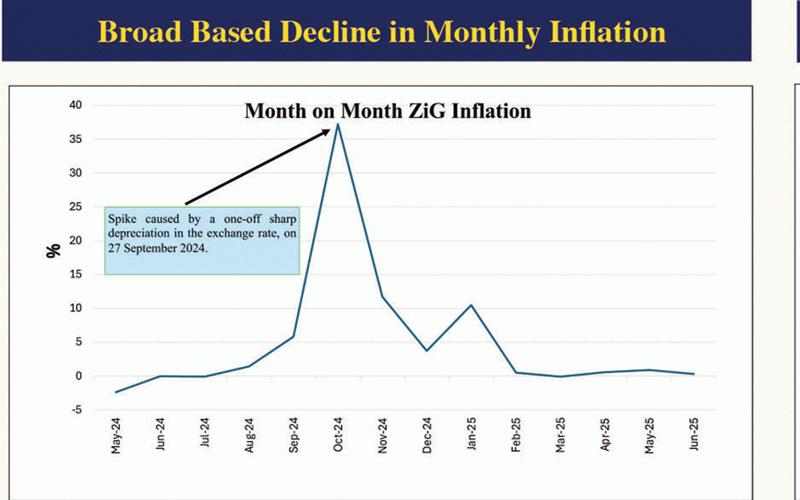
Economists raised red flags this week, as Zimbabwe’s central bank projected aggressive ZiG inflationary pressures will persist until the end of September, maintaining a stubborn trajectory, driven by base effects from the October 2024 currency upheaval, before easing to around 30% by December.
The Reserve Bank of Zimbabwe (RBZ) struck an optimistic tone in its second quarter report, despite an annual inflation rate that surged to 92,5% in June — the highest in southern Africa. It downplayed fears of renewed inflation spiral, urging markets to interpret the data within the context of technical distortions and recent price stability.
“The elevated year-on-year inflation from April to June 2025 — rising from 85,7% in April to 92,5% in June — was largely due to the impact of the once-off spike in the month-on-month rate of 37,2% recorded in October 2024,” the central bank said.
“This trend is expected to persist until September 2025, before decelerating to below 30% by the end of the year, aligning with the currently low and stable monthly inflation rates.”
The central bank’s statement appeared to be part of a strategy to re-anchor expectations, following months of heightened anxiety triggered by the transition to Zimbabwe Gold (ZiG) in April last year, and subsequent volatility in exchange rates. In October 2024, confidence in the ZiG — then only half a year old — plummeted, unleashing a 37,2% spike in monthly inflation — one of the sharpest increases since the currency relaunch.
Since then, authorities say monetary conditions have stabilised, aided by a tight monetary stance and improved exchange rate management. Month-on-month inflation has slowed considerably, reflecting a return to pricing discipline, at least in the short term. But the October base effect continues to distort year-on-year comparisons, pushing the headline figure well above what many Zimbabweans expected.
While authorities have attempted to recast the narrative, warning against misreading annual inflation data, economists say the public is still haunted by the ghosts of 2008, when hyperinflation peaked at an International Monetary Fund estimated 500 billion percent. Against that backdrop, even technical inflation of 92,5% is deeply unsettling.
“Inflation looks under control on a month-to-month basis, but the annual narrative continues to haunt Zimbabwe’s economic story,” said Tapiwa Sibanda, head of strategy at Trade Winds.
- Mbavara eyes to resurrect Matavire’s music legacy
- Zim exiles panic over SA permits
- Zim exiles panic over SA permits
- Social media platforms should act on hate speech
Keep Reading
“It reinforces the perception that hyperinflation risk is not fully extinguished. And in Zimbabwe, that perception alone can destabilise expectations.”
A Harare-based economist, who declined to be named, said while current price increases had moderated, the psychological impact of triple digit inflation prints cannot be underestimated. “Investors and consumers alike are not just reacting to prices — they are responding to risk. A headline number of 92,5% sends a dangerous signal, even if month-to-month inflation is stable,” the economist said.
The RBZ has maintained a tight monetary policy since November 2024, using open market operations and stringent liquidity controls to protect the value of ZiG. On the surface, those tools appear to be working. The ZiG/US dollar exchange rate has held relatively firm over the past two months, with parallel market premiums narrowing. But vulnerabilities remain. Zimbabwe’s macro-economic stability rests heavily on external inflows — chiefly from exports, remittances, and offshore credit lines.
The limited uptake of the ZiG in domestic transactions is another source of fragility. Central bank data shows the share of local currency in total payments fell from 43% in May to just 35% in June, a signal of waning confidence in the monetary system.
Policymakers are also wary of fiscal risks, particularly as government expenditure picks up ahead of the 2028 election cycle. Any deviation from the RBZ’s disciplined monetary framework could trigger renewed volatility in the second half of the year. Market watchers have warned that even minor slippages could push inflation expectations into dangerous territory.
In a region where most economies are grappling with inflationary aftershocks of global food and energy price shifts, Zimbabwe remains a distinct outlier. While Zambia’s inflation stood at 14,7% in June, Angola posted 21,3%, Malawi 28,6%, and South Africa just 5,5%. Even traditionally volatile Democratic Republic of Congo recorded an annual rate of 19,9% — still far below Zimbabwe’s 92,5%.
This context underscores the extent to which Zimbabwe’s inflation challenge is not regional but structural. It is rooted in deep-seated issues of monetary trust, fiscal credibility, and exchange rate rigidity.
For now, the RBZ is placing its bets on statistical normalisation. It hopes that by September, the October 2024 spike will fall out of the base, allowing year end inflation to land closer to its 30% target. But in an economy as scarred as Zimbabwe’s, recovery is not measured by numbers alone — it is measured by belief.






